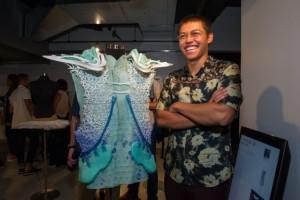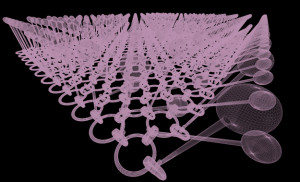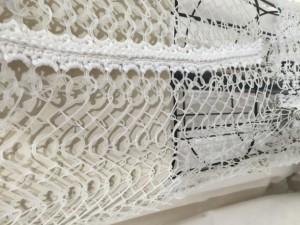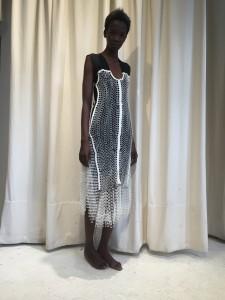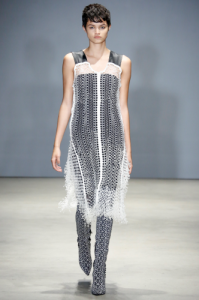 3D printing in fashion… Is it a new trend or is it a novelty? Often I am asked if I think 3D printed garments will replace traditional textiles and manufacturing. The simple answer is no. I believe that 3D printing will offer an alternative to traditional fashion manufacturing, and indeed will complement it. The fashion brand Ohne Titel just showed a dress during New York Fashion Week that explored the potential of merging 3D printing with traditional fashion techniques.
3D printing in fashion… Is it a new trend or is it a novelty? Often I am asked if I think 3D printed garments will replace traditional textiles and manufacturing. The simple answer is no. I believe that 3D printing will offer an alternative to traditional fashion manufacturing, and indeed will complement it. The fashion brand Ohne Titel just showed a dress during New York Fashion Week that explored the potential of merging 3D printing with traditional fashion techniques.
Ohne Titel is a womenswear label by designers Alexa Adams and Flora Gill. The designers met in 1999 while studying at Parson’s School of Design and worked together for Karl Lagerfeld before forming their own brand. Ohne Titel received the Ecco Domani Fashion Foundation Award for womenswear in 2009, was a finalist in the CFDA/Vogue Fashion Fund Awards in 2009 and 2011, and was nominated for the 2009 Textile Award. It shouldn’t be surprising that Adams and Gill turned to 3D printing for their latest project. Their brand is particularly interested in utilizing various technologies and techniques to create personalized fabrics for the confident modern woman.
Shapeways printed Ohne Titel’s latest dress, which was sponsored by Microsoft, and interviewed the designers about their process. As Flora Gill explains:
The dress was printed in Shapeways Frosted Detail Plastic, which is interesting in of itself. Most of the 3D printed garments that Shapeways has produced have used their Strong and Flexible Material, SLS printed nylon. Frosted Detail Plastic is more brittle than their nylon product and is generally used for small detailed models. However, the material is translucent and it is used to great effect in the Ohne Titel dress. In fact, the entire process of making the dress was unique and highly collaborative.“I love the unexpected mix of old-world and futuristic manufacturing. We looked to chainmail structures for inspiration and elongated our ‘chains’ to make a herringbone structure. It’s interesting to work with 3D modelers and the printers to see what is possible. 3D printing in some ways has limitless potential, but it is still very beta. We found many parallels with knitting technologies. In the beginning of our careers, it was usually difficult to computer program intricate knit programs. Now knitting machines are easily programmed and the techniques they create would have been unimaginable 10 years ago. We can’t wait to see what will be possible for knitting and 3D printing in the next 10 years.”
When Shapeways was pitched by Ohne Titel and Microsoft to create 3D printed garments for their AU16 runway show, Shapeways turned to designer Chester Dols. Dols designed some interwoven garments as part of the Eyebeam’s Computational Fashion Master Class that Shapeways sponsored. Dols’ designs were stylistically and aesthetically similar to the sketches that Ohne Titel provided to Shapeways, which led them to tap Dols for the project.
- Chester Dols with his garment at Re-Making Patterns, 2015
- Textile pattern by Dols for the Computational Fashion Master Class
- Closeup render of the Ohne Titel Dress. (Image courtesy of Ohne Titel)
- Closeup of the Ohne Titel dress. (Image courtesy of Ohne Titel)
Dols has a background in architecture and uses Rhino, Grasshopper and Python scripting to create his intricate designs. His interest in parametric design led to his participation in the Computational Fashion Master Class, and the rest as they say is history. Certainly, the Ohne Titel dress was a standout at New York Fashion Week. Dols was interviewed by Shapeways and had some interesting things to say about his designs and the future of 3D printed textiles.
3d printing is still in its infancy and so is the concept of 3d printed textiles. Like I mentioned before, I’m waiting for industries, technologies, and science to converge. When we can successfully and seamlessly print with multiple materials, that is when things will get interesting. Right now, there are printers which print with two materials; take for instance Shapeways’ frosted detail plastic, which prints a wax support material and a polymer resin at the same time. But what if the second or third material isn’t a support material? If we can get 3D printers working like a loom, weaving together many materials at once to create a ‘polyblend’ print with complex graded materiality, that’s when a new fashion will emerge.
It’ll be interesting to see the imact of 3D printing on the fashion world in the next ten years. Will new materials and printing technologies upset the status quo? Only time will tell. I guess it all depends on how far designers are willing to push the boundaries.
Below are some more images of the dress from the runway show:
- (Image courtesy of Ohne Titel)
Subscribe to Our Email Newsletter
Stay up-to-date on all the latest news from the 3D printing industry and receive information and offers from third party vendors.
Print Services
Upload your 3D Models and get them printed quickly and efficiently.
You May Also Like
Havaianas Collaborates with Zellerfeld to Launch 3D Printed Flip-Flops
The shoe of the summer is undoubtedly the flip-flop. Easy on, easy off, your feet won’t get sweaty because there’s not much material, and they’re available in a veritable rainbow...
UCLA Researchers Develop 3D Printed Pen that May Help Detect Parkinson’s Disease
Diagnosing Parkinson’s disease is difficult. Often, early symptoms of the progressive neurological condition may be overlooked, or mistaken for signs of aging. Early diagnosis can help save lives and improve...
Printing Money Episode 30: Q1 2025 Public 3D Printing Earnings Review with Troy Jensen, Cantor Fitzgerald
Printing Money is back with Episode 30, and it’s that quarterly time, so we are happy and thankful to welcome back Troy Jensen (Managing Director, Cantor Fitzgerald) to review the...
Heating Up: 3D Systems’ Scott Green Discusses 3D Printing’s Potential in the Data Center Industry
The relentless rise of NVIDIA, the steadily increasing pledges of major private and public investments in national infrastructure projects around the world, and the general cultural obsession with AI have...



